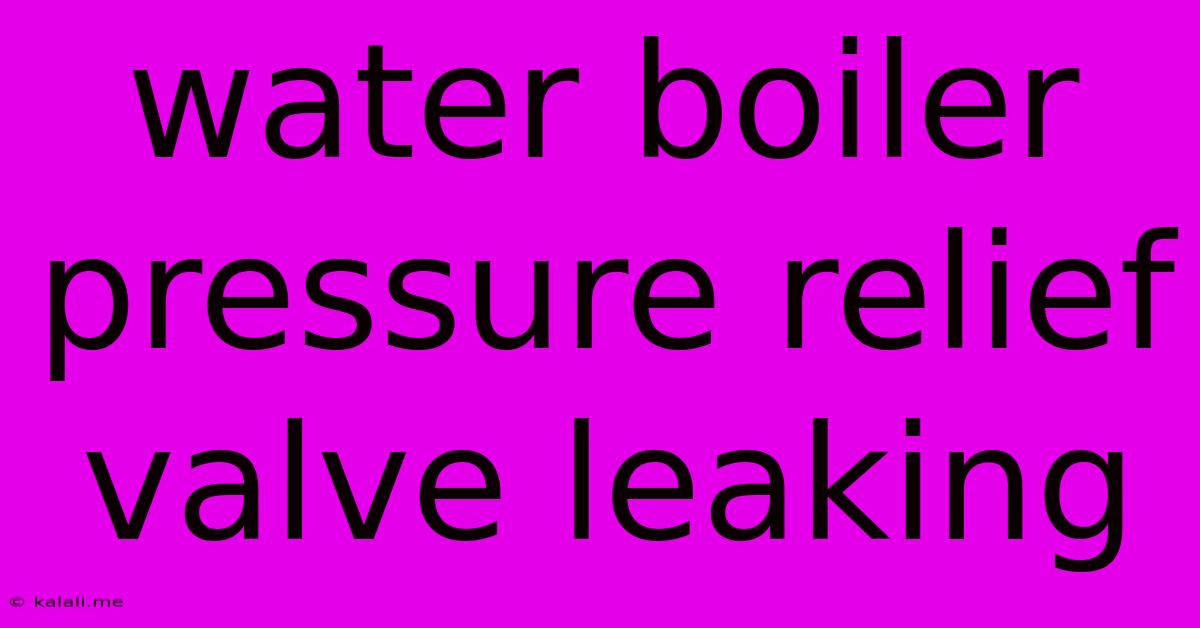Water Boiler Pressure Relief Valve Leaking
Kalali
Jun 03, 2025 · 4 min read

Table of Contents
Water Boiler Pressure Relief Valve Leaking: Causes, Solutions, and Prevention
A leaking pressure relief valve on your water boiler is more than just an annoying drip; it signals a potential safety hazard. This article will delve into the common causes of this issue, explain how to diagnose the problem, and offer solutions to fix it, along with preventative measures to avoid future leaks. Understanding your water heater's pressure relief valve is crucial for maintaining safety and efficiency.
Understanding the Pressure Relief Valve
The pressure relief valve (PRV), also known as a temperature and pressure relief valve (T&P valve), is a crucial safety device in your water boiler. Its purpose is to release excess pressure and steam to prevent the tank from exploding due to overheating or excessive pressure buildup. This pressure can build up from various factors including a faulty thermostat, heating element issues, or even external water pressure fluctuations. A leaking PRV might indicate a problem within the system that requires attention.
Common Causes of a Leaking Pressure Relief Valve
Several factors can lead to a leaking PRV. Identifying the root cause is key to a lasting solution. These include:
- Excess Water Pressure: High water pressure from your main supply line can force the valve to leak, even if the water boiler itself isn't over-pressurized. This is a common issue in areas with high water pressure. Consider installing a pressure regulator to address this.
- Faulty Valve: Over time, the valve's internal components can wear out or become corroded, leading to leaks. Mineral deposits from hard water can also contribute to this. This is often the simplest explanation for a consistent drip.
- Sediment Buildup: Minerals and sediment accumulating within the water boiler can restrict water flow, leading to increased pressure and forcing the valve to leak. Regularly flushing your water boiler can help prevent this.
- Temperature and Pressure Fluctuations: Frequent and significant changes in water temperature and pressure can put strain on the valve, increasing the likelihood of leakage. This could be caused by inconsistent heating elements or even external factors affecting your water supply.
- Malfunctioning Thermostat: A faulty thermostat might cause the water to overheat, triggering the pressure relief valve to release excess pressure. This is a potential safety risk and should be addressed immediately.
Diagnosing the Problem: Is it Just a Drip or Something More Serious?
Before jumping to conclusions, accurately assess the leak. A slight drip after the water boiler has heated might be normal due to slight pressure changes as the water cools. However, a constant stream or a leak accompanied by other issues (like unusually hot water or unusual noises from the boiler) requires immediate attention.
Check for:
- The frequency and volume of the leak: A slow drip is less concerning than a steady stream.
- Water temperature: Is the water excessively hot, even when the boiler isn't heating?
- Other signs of malfunction: Listen for unusual noises coming from the water boiler; these could indicate additional problems.
Solutions and Repairs
The solution depends on the underlying cause. If you're not comfortable working with plumbing and electrical systems, it's best to call a qualified plumber. However, you can take some preliminary steps:
- Check and adjust your water pressure: If you suspect high water pressure, installing a pressure regulator is the best long-term solution.
- Flush the water boiler: Removing sediment buildup can alleviate pressure and might solve the problem. Follow manufacturer instructions for proper flushing.
- Replace the pressure relief valve: If the valve is faulty, replacing it is often the most effective solution. Ensure you get a valve with the correct pressure rating for your boiler. This is a relatively straightforward DIY task for those with some plumbing experience, but safety should always be prioritized.
Prevention is Key: Maintaining Your Water Boiler
Regular maintenance is crucial to prevent a leaking PRV and ensure your water boiler's longevity. This includes:
- Annual inspections: Have a qualified professional inspect your water boiler annually to identify potential issues early.
- Regular flushing: Flush your water boiler every 6-12 months, depending on water hardness in your area.
- Monitor water pressure: Keep an eye on your water pressure and install a pressure regulator if needed.
A leaking pressure relief valve is a serious issue that shouldn't be ignored. By understanding the causes, diagnosing the problem accurately, and taking preventative measures, you can ensure the safety and efficiency of your water boiler for years to come. Remember, if you are unsure about any repair, always consult a qualified professional.
Latest Posts
Latest Posts
-
Theres As Many Locks And Keys As You Allow
Jun 05, 2025
-
How To Determine The Resident Frequency Of A Element
Jun 05, 2025
-
Why Did Erens Dad Let Eren Eat Him
Jun 05, 2025
-
How Do I Open A Beer Bottle Without An Opener
Jun 05, 2025
-
Can You Put Latex Paint Over Oil Based Primer
Jun 05, 2025
Related Post
Thank you for visiting our website which covers about Water Boiler Pressure Relief Valve Leaking . We hope the information provided has been useful to you. Feel free to contact us if you have any questions or need further assistance. See you next time and don't miss to bookmark.